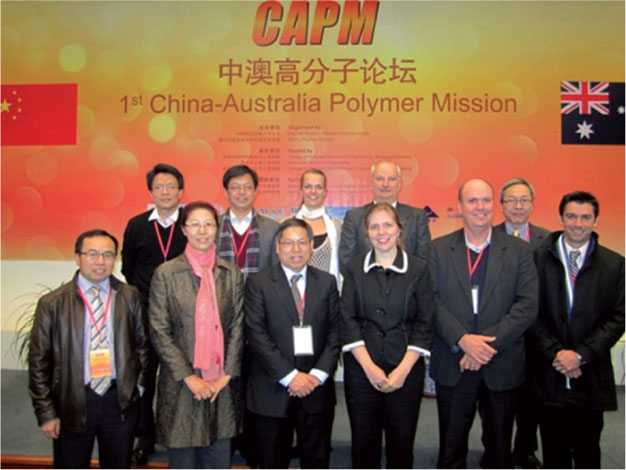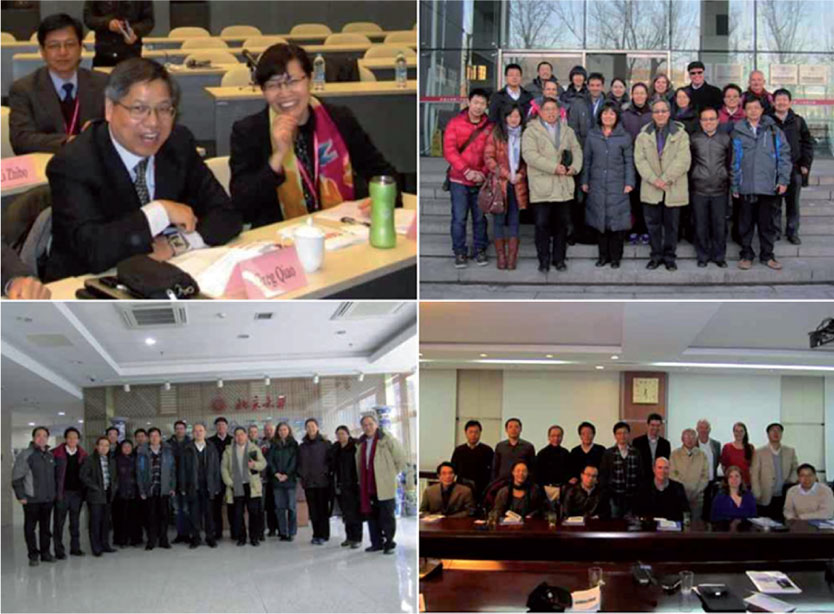Frontiers in Sino-Australian Polymer Science and Engineering
Greg G. QiaoDepartment of Chemical and Biomolecular Engineering, The University of Melbourne, Parkville, Victoria 3010, Australia. Email: gregghq@unimelb.edu.au

Professor Greg Qiao received his B.Eng. in polymer engineering from Donghua University in 1982 and his Ph.D. in synthetic organic chemistry from the University of Queensland in 1996. He then worked at The University of Melbourne, where he entered the field of synthetic polymer chemistry and engineering. He started as a lecturer in the Department of Chemical and Biomolecular Engineering in 2002 and was promoted to Senior Lecturer in 2004, Associate Professor and Reader in 2007, and full Professor in 2009. He has also been an ARC Future Fellow since 2012. His main research focuses on the synthesis of novel macromolecular architectures, polymeric membranes, functional polymers, and biomaterials. |
Australian Journal of Chemistry 67(1) 3-5 https://doi.org/10.1071/CH13656
Published: 6 January 2014
Welcome to this Special Edition of the Australian Journal of Chemistry, entitled Frontiers in Sino-Australian Polymer Science and Engineering, which showcases recent progress in Australian and Chinese polymer research. The articles contained in this special issue are drawn from key polymer chemistry and engineering laboratories from both countries, whose leaders met in January 2013 for an intensive week of scientific exchange.
Polymers are a part of daily life for all of us, be it in health, food packaging, personal electronics, or one of the many industrial applications that polymers are used in; they surround us everywhere, every day. Polymers are therefore a key component of material science and engineering, and polymer research has been a strength of many research institutions in both countries for a long time. Australia and China can look back with pride on more than three decades of successful polymer science and technology cooperation, which includes discoveries and improvements in areas as diverse as water conservation, mining efficiency, medical research, cleaner energy, food security, and disaster management. The two nations have many complementary research strengths in the field of polymers: while Australian researchers are world leaders in advancing polymer synthesis and characterization (e.g. nitroxide-mediated radical polymerization (NMP) and reversible addition–fragmentation chain transfer (RAFT) polymerization methods), Chinese polymer chemists excel at developing industrial applications for polymers (e.g. polymer membranes for clean energy technologies, chemical fibre technologies). Both the Australian and the Chinese governments recognise the importance of research in the area of polymer science and engineering, and polymer science has featured on the list of important research areas in both countries for many years. It is currently listed among the six most important research areas by the Chinese government and is represented in the Australian government’s National Research Priority ‘Frontier Technologies for Building and Transforming Australian Industries’ with its associated priority goal ‘Advanced Materials’.
Thanks to funding provided by the Australia-China Science and Research Fund, an initiative of the Australian Government’s Department of Innovation, Industry, Science, Research and Tertiary Education (DIISRTE), I, with Dr Katharina Ladewig (The University of Melbourne) as activity coordinator, had the pleasure of leading a delegation of outstanding Australian polymer scientists on an official visit to key polymer science and research laboratories in China earlier in 2013. The Australian delegation comprised Drs Cyrille Boyer, Xiaojuan Hao, Professors David Lewis, Dan Li, Martina Stenzel, Dr San Thang, Professors Xungai Wang, Andrew Whittaker, and Dr Xiaoqing Zhang. The 1st Australia China Polymer Mission included attendance of the 1st China–Australia Polymer Meeting (CAPM) hosted by Professor Meifang Zhu at Donghua University (20–21 January 2013; Fig. 1) and subsequent visits of the delegation to the Chinese Academy of Sciences (CAS) in Beijing, Donghua University, Fudan University, Nankai University, Peking University, Shanghai Jiao Tong University, Tianjin University, and Tsinghua University (Fig. 2). The Chinese participants at the 1st CAPM and subsequent hosts at their respective home institutions were Professors Amin Cao, Chao Gao, Junpo He, Zhibo Li, Linqi Shi, Jing Shen, Xinhua Wan, Xu-Ming Xie, Shuguang Yang, Xiaoyan Yuan, Jiong-Xin Zhao, and Jongfeng Zhou.

|
Both the 1st CAPM and the subsequent visits were a great success and we all look forward to intensified collaborations and scientific discussions in the near future. The key outcomes of the bilateral talks held as part of CAPM were:
-
a resolution to continue these activities on an annual basis, with the next CAPM to be held in Australia in 2014
-
a decision to build a multilateral, cross-disciplinary, and cross-institutional research network of Australian and Chinese research scientists interested in polymer science and engineering and/or polymer applications, the Australia–China Polymer Network (ACPN).
-
a pledge to aim for an increase in the number of joint publications, grant applications, and students.
Our visits to the individual research centres revealed great potential for future collaborations in a whole host of different polymer science and technology research fields and application areas, such as cyclodextrin-based supramolecular assemblies (Fudan University, Shanghai Jiao Tong University, The University of Melbourne), biomaterials for regenerative medicine, targeted gene and drug delivery, and biomedical imaging (CAS, Nankai University, Tianjin University, Tsinghua University, CSIRO, The University of Queensland, The University of NSW, The University of Melbourne), controlled polymerization techniques offering sequence and chirality control (Nankai University, Tianjin University, Tsinghua University, Peking University, CSIRO, The University of Melbourne, The University of NSW, The University of Queensland), graphene-based materials (Nankai University, Monash University), conductive and light-responsive materials (Tsinghua University, Flinders University), chemical fibre development (Donghua University, Deakin University), and many more.
This Special Issue of the Australian Journal of Chemistry highlights latest research outcomes in these key areas by both Australian and Chinese CAPM participants. Together with the co-guest editor of this issue Professor Meifang Zhu (Donghua University), I invite you to browse the following pages and trust that you will find them as informative and inspiring as we did.



